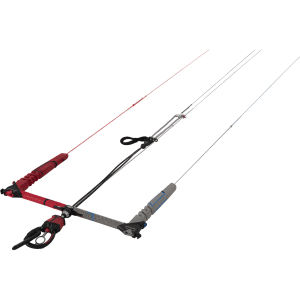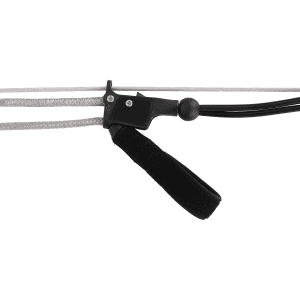

Y27 RRD Global Bar
€579.00 Original price was: €579.00.€369.00Current price is: €369.00.
MOLDED FLOATING SIDE CAPS INJECTED WITH HIGH MEMORY EVA
NEW IMPROVED STAINLESS STEEL DE-POWER ROPE CLEAT
NEW CNC POLISHED ALUMINUM MIDDLE BAR CONNECTOR
2 DIFFERENT SIZES AVAILABLE 52CM (23 MT LINES) AND 48 CM (21 MT LINES)
VELCRO LOOP TO PREVENT DE POWER ROPE FLAPPING
BLACK BACK LINES AND WHITE FRONT LINE
VIDEO
SIMPLICITY IS OUR MISSION. WE REMOVE ANY UNNECESSARY ITEMS, INSTEAD OF ADDING THEM, TO MAKE EVERY COMPONENT MORE FUNCTIONAL. SIMPLY SAID:
YOU CANNOT BREAK WHAT DOES NOT EXIST
GLOBAL BAR TECHNOLOGY
MOULDED FLOATING SIDE CAPS

Moulded floating side caps injected with high memory EVA which facilitates a better bar grip and increased safety.
ALUMINIUM CENTRAL BAR

CNC milled and polished aluminium central bar component with oversized oval recesses to improve de-power tube sliding; even during some extreme steering.
CHICKEN LOOP SAFETY RELEASE

Chicken loop safety release system with oversized handle and increased sliding potential of all components to secure an effective functionality over the years. This safety release system has the least amount of steel components on the market, meaning a longer lifetime and less maintenance.
STAINLESS STEEL DE-POWER ROPE CLEAT

Customized stainless steel de-power rope cleat designed around the double chamber tube, allowing the security line to slide freely.
RIGID THREAD LINES
In addition to the new features, the ‘RRD Global Bar Y26’ is still equipped with special lines called “RIGID THREAD LINES”. These are used exclusively on the RRD bars with great success for over 7 years. A product that’s now widely tested around the world, but there is little known about the details by kiteboarders.
All our lines are produced and developed in Italy, with a worldwide patent granted only to RRD.
The ‘Rigid Thread Lines’ are the result of the collaboration with an Italian manufacturing company that has more than fifty years of experience in the processing of lines and ropes, using the most recent and innovative exotic fibers, combined with an intimate knowledge of the physical and mechanical properties of Dyneema.


WHY ARE THE ‘RIGID THREAD LINES’ DIFFERENT?
The difference of our lines is that conventional Dyneema braided lines also have excellent breaking resistance characteristics, but can’t keep their original length when under tension. This is due to their entirely braided structure that sees the fibers being crossed over each other with an angle of approximately 30° compared to the load angle (0°). Once a conventional braided line is under tension it’s fibers will tend to align towards the load line and progressively start to stretch. A conventional braided line will stretch up to 10% of their original length when under load. (so a 25 meter line can stretch up to 25 cms)
Imagine by comparison the ‘Rigid Thread Lines’ like a widely used electric cable. Core copper wires are covered with a plastic protection sock. In the ‘Rigid Thread Lines’ copper is replaced by unidirectional Dyneema pre-tensioned fibers instead of braided fibers, covered (like the plastic part on the electric cable) with a very thin braided Dyneema sock to keep the internal non-braided unidirectional fibers in place and protecting them from abrasion.
This allows to create an absolutely direct connection between the bar and the kite, since what connects them together is an unidirectional non braided fiber core.
For this reason our exclusive ‘Rigid Thread Lines’ have a maximum stretch of 0,1% (so a 25 meter line can stretch up to max. 2,5 cms).
The ‘Rigid Thread Lines’ of RRD Kites will never be subject to adjustment, since they won’t even stretch under stress-related moves, for example by extreme loops or other radical manoeuvers, and consequently it is impossible to end up with stretched lines and/or of a different length and therefore the trim of the kite remains unchanged through the years.
The ‘Rigid Thread Lines’ will always be visually, technically and feeling compact and rigid throughout the course of their lives, maintaining all it’s physical and technical characteristics unaltered over the time.
The standard braided kite line has more stretch, which results in different line lengths, power absorption and reduction of performance, especially at the moment where you change the direction of the kite, where the load of the lines reaches it’s peaks.

Another weakness of the standard braided line that ‘Rigid Thread Lines’ have turned into a strength are unchanged compactness of the line.
Any new conventional line, has a rigid and compact character because of the resin (generally polyurethane-based) that encompasses it. This resin has a very short life and after only a few sessions, the touch of the product is softer.
This translates into a series of annoying consequences such as:
- The softened lines are more subject to unwanted knots.
- The protection of the line is reduced after each session.
- The braid tends to open and it becomes more fragile, allowing the entry of water which will create small salt crystals inside in case you kite in salt water, which can impair the bearing structure of the line.
WHY ARE RRD KITE LINES INNOVATIVE?
Unlike standard braided lines, the unidirectional structure of ‘Rigid Thread Lines’ provides a fiber memory that is significantly more efficient. A standard braided line under stress combines all ‘dynamic elongation’ of the fiber and flattening of the braid, whereas the core unidirectional structure uses exclusively the elastic modules of the fiber.
Tutustu myös
Puomit





